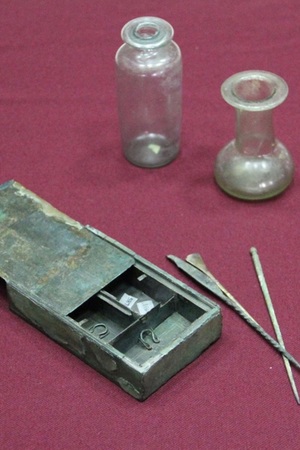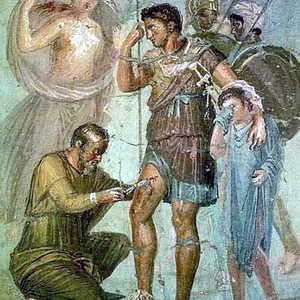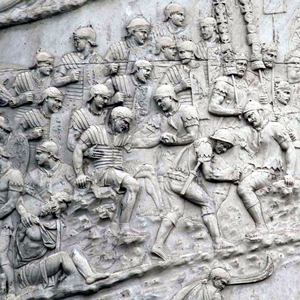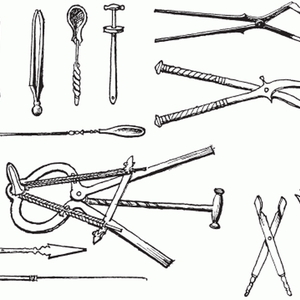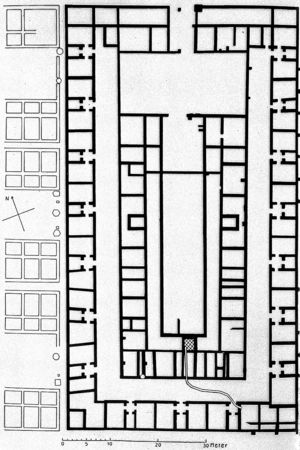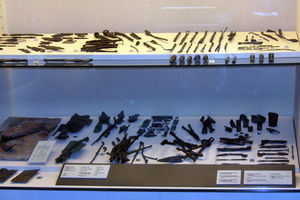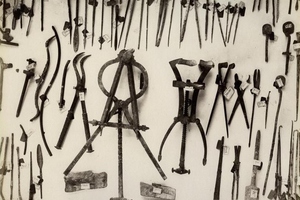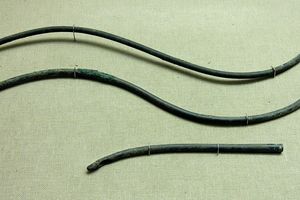Medicine in Ancient Rome
The medical knowledge of ancient Rome was largely based on the teachings of the Greek physician Hippocrates. The Romans actively used all the methods of diagnosis and treatment known in ancient Greece. Herbology was developed at a high level, which formed the basis for many modern ideas about medicinal plants.
Many Greek doctors came to Rome. Many of them firmly believed in achieving the right balance of the four fluids and restoring patients ' natural warmth. Around 200 BC, many wealthy families in Rome had personal Greek doctors. By about 50 BC, it was common to have a Greek doctor.
The basis of the medical teaching of Ancient Rome was the knowledge obtained from Greek medicine. First of all, they used the works of Hippocrates, which contain descriptions of many diseases and methods of their treatment.
Medical schools in Ancient Rome appeared in the era of the republic. It was believed that a doctor should have knowledge from various disciplines. Some healers were trained in military hospitals. Helping the wounded, they acquired new knowledge in the field of anatomy and physiology.
Examples of doctors
Dioscoride
Pedanius Dioscorides (c. 40-90 AD) was a Greek botanist, pharmacologist, and physician who practiced in Rome during the reign of Nero. Dioscorides studied botany and pharmacology at Tarsus. He became a famous army surgeon in Rome. Traveling with the army, Dioscorides was able to experiment with the medicinal properties of many plants. Compared to his predecessors, his work was considered the largest and most thorough in terms of naming and writing about medicines, many of the works of Dioscorides ' predecessors have been lost. Dioscorides wrote the 5-volume encyclopedia De Materia Medica, which lists more than 600 medicines that make up an influential and long-standing pharmacopoeia . De Materia Medica was widely used by physicians for the next 1,500 years. In his five books, Dioscorides mentions about 1,000 simple medicines. Also in his books, Dioscorides calls opium and mandrake a sleeping pill that can be used as a natural surgical anesthetic.
Soranus
Soranus was a Greek physician, born in Ephesus, who lived during the reigns of Trajan and Hadrian (98-138 AD). According to the Court, he studied at the medical school in Alexandria and practiced in Rome. Soranus was part of the Methodist school of Asclepiades, which promoted the ideals of the Hippocratic doctrine. He was the main representative of the Methodical School of Doctors. Soranus ' most famous work was his book Gynecology, in which he discussed many topics that are considered modern ideas, such as birth control, pregnancy, midwife duties, and postpartum care. His treatise "Gynecology" (first published in 1838, later by W. Rose in 1882, with a sixth-century Latin translation by Mushio , a doctor of the same school) has been preserved. It explains the internal difficulties that can arise during childbirth for both the mother and the fetus. He also worked with fractures, surgery, and embryology.
Galen
Galen (129 AD-c. 200 or 216 AD) of Pergamum was a prominent Greek physician whose theories dominated Western medicine for more than a millennium. By the time he was 20, he had served for four years in a local temple as a therapist ("helper "or" helper") to the god Asclepius . Although Galen studied the human body, dissecting human corpses was against Roman law , so instead he used pigs, monkeys, sheep, goats, and other animals. While studying animal dissection, Galen applied his discoveries to animal anatomy and developed a theory of human anatomy. Galen moved to Rome in 162. There he lectured, wrote extensively, and publicly demonstrated his anatomical knowledge. He soon gained a reputation as an experienced doctor, attracting a large number of patients to his practice. Among them was the consul Flavius Boethius, who introduced him to the imperial court, where he became physician to the Emperor Marcus Aurelius . Despite being a member of the court, Galen reputedly avoided Latin, preferring to speak and write in his native Greek, which was quite popular in Rome. He treated Roman luminaries such as Lucius Verus, Commodus, and Septimius Severus . In 166, Galen returned to Pergamum, but returned permanently to Rome in 169. Galen followed the Hippocratic theory of the four fluids, believing that a person's health depends on a balance between the four main body fluids (blood, yellow bile, black bile, and sputum). It was thought that food was the original object that allowed these fluids to be stabilized. In contrast, medications, venesection, cauterization, and surgery were radical and should only be used when diet and regimen no longer helped. The survival and evolution of Hippocratic medicine is attributed to Galen, who combined the four qualities of cold, heat, dryness, and humidity with the four basic body fluids, and remained in the health field for another millennia or so. Galen wrote a short essay titled; "The best doctor is also a philosopher" , where he writes that a doctor should understand not only physical, but also logical and ethical philosophy. He writes that a doctor "must be able to reason about the problems presented to him, must understand the nature and functions of the body in the world of doctors, must exercise moderation and despise all money." The ideal doctor treats both the poor and the chosen fairly and studies everything that affects health. Galen believed that eleven years of study was enough time to become a competent doctor. He refers to Hippocrates in his writings, saying that the Hippocratic literature is the basis of doctors ' behavior and treatment. Galen's writings have survived longer than those of any other ancient medical researchers.
The Asclepiades
Asclepiades trained as a physician in Alexandria and practiced medicine in Asia Minor as well as Greece before he moved to Rome in the 1st century BC. His knowledge of medicine allowed him to succeed as a doctor. Asclepiades was a leading physician in Rome and a close friend of Cicero. He developed his own version of the molecular structure of the human body. The atomic model of Asclepiades contained atoms of different shapes that passed through the pores of the body. These atoms were round, square, triangular. Asclepiades noted that as long as the atoms move freely and continuously, human health is preserved. He believed that if the atoms were too large or the pores were too narrow, then the disease would manifest as a multitude of symptoms, such as fever, cramps, or, in more severe cases, paralysis. Asclepiades firmly believed in hot and cold baths as a cure for diseases; his methods deliberately did not cause the patient much pain. Asclepiades used methods to cause the least discomfort while continuing to treat the patient. His other medications included listening to music to induce sedation, and drinking wine to treat headaches and fevers. Asclepiades is the first doctor in Rome to use massage therapy.
Aulus Cornelius Celsus
Celsus (25 BC-50 AD) was a Roman encyclopedist who wrote a general encyclopedia on many subjects. His exact place of birth, as well as the time when he lived, is unknown, but it is known that he lived during the reigns of Augustus and Tiberius. The only surviving work from his large encyclopedia is "Medicine". This work consists of eight volumes, two of which are devoted to surgery. De Medicina provides some of the best reports on Roman medicine of its time. Its contents proved valuable even in the 15th century after Pope Nicholas V rediscovered it, becoming the first medical book published in 1478 AD. It is still debated whether he practiced medicine himself or simply compiled works of the time, mostly from Greek sources. This is important because at that time the Romans looked down on the Greeks, as they did on the work of doctors. In his book, he discussed two different schools of thought related to medicine at the time, which he calls " empiricism "and"dogmatics." Empiricists followed empirical observations, and dogmatists needed to understand the theory behind how treatment works. Celsius is also credited with describing four of the five characteristics of inflammation, redness (scarring), swelling (swelling), heat (caloric content), and pain (aches). Galen would have written about the fifth, the loss of function (functio laesa).
Medications and treatment methods
The treatment methods used were a combination of drug therapy, as well as various magical and religious rituals. Doctors knew about the benefits of a healthy diet, exercise, daily routine, and fresh air.
Herbology was widely used in Ancient Rome. It is believed that it became the basis of modern knowledge about medicinal plants. Herbs, minerals, and potions made from several different ingredients were used for medicinal purposes.
A catalog written by the military doctor Dioscorides has come down to our time. It describes about 600 types of medicinal plants and almost 1,000 potions that he used to treat his patients. Another source of comprehensive information about medicinal plants was the books of Pliny.
Initially, medicinal herbs were collected and dried at home, since there were no pharmacies in Rome. Potions from them were also prepared independently. Later, traveling merchants appeared – pharmacopoeia, who offered medicinal plants and prepared tinctures and powders from them. However, they were considered notorious charlatans.
In the first century AD, a botanical garden appeared in Ancient Rome, where many famous medicinal herbs were bred, and it belonged to Anthony Castor.
Proper diet was considered an important element of a healthy lifestyle. Food was thought to have a curative or causal effect on illness, as determined by its effect on humor; as well as disease prevention. Moderation in food was the key to a healthy lifestyle and gave rise to the philosophy of healthy eating. When the diet ceased to promote health, medications, bloodletting , moxibustion, or surgery were used. Patients taking control of their lives, adhering to their preventative treatment diet, and the freedom to see doctors indicate that patient autonomy was valued.
Roman doctors used a wide range of herbs and other medicines. Their ancient names, often derived from Greek, do not necessarily correspond to separate modern species, even if they share the same names. Known medications include:
- Fennel (Hippomaratron) - Treats painful urination; expels menstrual discharge; stops intestinal discharge; removes breast milk; breaks down kidney and urinary stones.
- Rhubarb (Ra) - For flatulence, convulsions, internal diseases (stomach, spleen, liver, kidneys, uterus, peritoneum), sciatica, asthma, rickets, dysentery, etc.
- Gentian (Gentiane) - Warming, astringent; for venomous bites, liver diseases; causes abortion; treats deep ulcers, eye inflammation.
- St. John's Wort (Aristolochia) - Poisonous; helps with childbirth.
- Licorice (Glucorhiza) - Calms the stomach; diseases of the chest, liver, kidneys and bladder.
- Aloe - Heals wounds (applied in dry form); removes boils; laxative; treats alopecia.
Statues and healing shrines were places of prayer and sacrifice for both the poor and the chosen, and were common throughout the Roman Empire. The veneration of shrines and statues reflected the search for healing, guidance, and alternatives to ineffective human doctors and medicines. In 2013, Italian scientists examined the contents of a Roman shipping vessel known as Relitto del Pozzino, which sank off the coast of Populonia , Tuscany , around 120 BC, and was excavated in the 1980s and ' 90s. The vessel contained a first-aid kit with pixides inside, which contained medicinal pills or pills full of a number of zinc compounds, as well as iron oxide, starch, beeswax, pine resin, and other plant-based materials that probably served as a kind of eye medicine or eye wash.
The overall goal of the doctor was to help those suffering from illnesses or injuries as much as possible; trust in the doctor was based on their successful recovery. Of course, they couldn't reliably treat ailments; sometimes the best they could hope for was that their treatment wouldn't make their patients ' problems worse. Many doctors have been criticized by their peers for failing to cure an obvious simple illness. The gaps in medical care were filled by several types of supernatural medical care; the Romans believed in the power of divine messages and healing. There were descriptions of many gods from different religions who dealt with destruction or healing. For example, in 431 BC, in response to the plague raging throughout Italy, the temple of Apollo Medica was recognized as healing. Descriptions of healing shrines dedicated to various healing gods are scattered throughout Greco-Roman and Egyptian history. Sick or wounded Romans often flocked to temples dedicated to Asclepius, the god of healing, as it was believed that the god actually inhabited the sanctuary and gave divine healing to petitioners. The process itself was simple: the patient made a specific donation to the temple, and then went through a process called "incubation," during which they moved to a special room where god could contact them, often through dreams. which God either prescribed or took care of himself. Often, the type of treatment prescribed would be very similar to the actual medical practice of doctors at the time. This type of supernatural care did not contradict the main direction of health care. Doctors would often recommend that patients go to a healing sanctuary when they were stricken with an illness that the doctor couldn't cure. This allowed the doctor's reputation to remain intact, as it was perceived as a referral rather than a failure.
Colostrum is the first form of milk produced by nursing mammals. Both Greek and Roman medical texts prescribe the use of various substances of various medical and religious significance. Some substances , such as sulfur, asphalt, and animal excrement, have been linked to the practice of human purification. The practice of using human breast milk as medicine has very early roots in Egyptian medical texts. In several such texts, there are references to the use of milk by a woman who has given birth to a male child. This practice is believed to be based on the images on several statues of the goddess Isis nursing her son, the god Horus . Both Egyptian and Greek texts state that milk used for medicinal purposes should only come from a woman who has given birth to a male child. In Greek and Roman cultures, breastmilk treatments were very different. In Greek medicine, milk was consumed very rarely. Instead, it was used in recipes for ointments and detergents to treat burns and other skin conditions. These procedures were applied exclusively to women, as women's bodies were considered "contaminated"in a sense. In contrast, the Romans used colostrum more widely and in a variety of ways. Stories suggest that adult breast milk consumption was considered socially acceptable, but was not common unless used for treatment. Instead, the patient swallowed milk and the treatment was given to both men and women, allowing the female body to be viewed as similar views to their male peers, rather than the opposites they had been for centuries before. Overall, while not all fears about changing medical views on female physiology have disappeared, the Romans seem to have been less concerned about the so-called "contamination" of the female body, and therefore needed women to have the special needs needed to "purify"themselves.
Hospitals
In the Roman medical system, the first hospitals were established; they were intended for slaves and soldiers. Doctors were assigned to accompany armies or ships, treating the wounded. In Rome, deaths were caused by a combination of poor sanitation, famine, disease, epidemics, malnutrition, and war, resulting in a high death rate for the Romans. The development of medical services was promoted by the unfriendly attitude of the Romans to the sick, superstitions and religious beliefs. The earliest known Roman hospitals of the Roman Empire were built in the first and second centuries AD, during the reign of Emperor Trajan . The expansion of the army beyond the Italian Peninsula meant that the wounded could no longer be treated in private homes. For this reason, the valetudinary was opened . Valetudinaria (plural of valetudinarium) were field hospitals or flying military camps and started out as a small cluster of tents and fortresses dedicated to the wounded that provided an understanding of how doctors managed various wounds and illnesses that allowed an awareness in which herbs were good for certain medical purposes. Over time, temporary forts became permanent structures. The original hospitals were built along the main roads and soon became part of the Roman fort's architecture . They were usually placed against the outer wall in a quiet part of the fortification.
The standard valetudinary was a rectangular building consisting of four wings connected by a lobby, which could be used as a sorting center. Each Legion's hospital was built to house between 6% and 10% of the legion's 5,000 soldiers. The building also had a large hall, reception area, outpatient clinic, kitchen, staff quarters, as well as washbasins and toilets. Medicine in Ancient Rome.
Surgical instruments
Surgery was usually used as a last resort because of the risks involved. However, when surgery did occur, it was usually limited to the surface of the body, because doctors recognized that injuries related to the most important physiological functions of the body (brain, heart, spine, etc.) are usually not treatable. Many surgical instruments very similar to modern medical instruments are known from archaeology and Roman medical literature, including:
- Rectal mirror
The instrument mentioned by Hippocrates that allows doctors to examine the patient's rectal cavity.
- The Spoon of Diocles
This tool is mentioned by Cornelius Celsus as a method of removing arrowheads and other jagged objects. The tool was a narrow spoon with a hole in the bottom for attachment to the tip of the arrow. The other part of the tool was a smooth blade designed to protect the other side of the tool. There are doubts about the authenticity of the existence of this medical device, because it was mentioned only by Celsus, without any other confirmation by other authors. Similarly, no surviving relics have yet been found, which raises doubts about its actual existence.
- Bone Levers
A tool used to return the bones to their proper place in the limb. It is quite possible that it was used for teeth.
- Vascular cupping Containers used for bloodletting. Vessels of different sizes were used depending on the expected amount of blood. For example, as in our days, the larger the area of the body that needed to be treated (such as the back or thighs), the larger the cupping device was. It would be the other way around, there would be the use of smaller bowl-shaped devices for the hands or neck, respectively.
- Tubes
After surgery, usually on sensitive areas such as the nose, rectum, or vagina, a bronze or lead tube was inserted to prevent adhesions or contractions. It will also be used for transporting medical supplies.
- Moxibustion tile
This tool has been used for several purposes, such as stopping bleeding, cutting flesh, or removing growth tumors.
- Surgical scissors
According to the works of Oribasius and Celsus, cutting hair was actually considered a medical procedure. It is also used to obtain a smooth edge in surgical procedures (for example, when cutting tissue) compared to the sharpness of scissors.
- Spatula probe
Also known as "spatomele". A two-way instrument used by almost every doctor, but mostly used for pharmaceutical drugs. One end was used to mix medicines, and the other end was flat and used to distribute medicines on the affected part of the patient.
- Scalpels
It can be made of steel or bronze. Ancient scalpels had almost the same shape and function as modern ones. The most common type of scalpel was the longer steel scalpel. They can be used for a variety of cuts, but they seem to be particularly suitable for deep or long cuts. Smaller bronze scalpels, called pot-bellied scalpels, were also often used, as the shape allowed for delicate and precise incisions.
- Obstetric hooks
Referred to in both Greek and Latin literature, obstetric hooks and sharp hooks were common tools used by both Roman and Greek physicians. There were two main types of hooks: sharp and blunt. Blunt hooks were used primarily as probes for dissecting and lifting blood vessels (similar to the modern aneurysm needle). Sharp hooks, on the other hand, were used to hold and lift small pieces of cloth so that they could be extracted, and to retract the edges of wounds.
- Bone Drills
They are rotated by the strap in various configurations. They were used to remove affected bone tissue from the skull and to remove foreign objects (such as weapons) from the bone.
- Bone Forceps
It is used to extract small fragments of bone that could not be captured with your fingers. Soranus uses it as a tool in case of an accident with the fetal skull.
- Men's catheters
It is used to open a blocked urinary tract so that urine can flow freely out of the body. Early catheters were hollow tubes made of steel or bronze and had two main designs. There were catheters with a small S-curve for male patients and a more direct one for women. There were devices of a similar shape, called bladder sounds, that were used to probe the bladder for calcifications.
- Tongue tongs
These serrated forceps with small teeth were designed for tongue amputation. The doctor crushed the tongue with forceps before cutting it off to reduce the bleeding. One of the tools needed by Hippocratic doctors
- Vaginal mirrors
Among the most sophisticated instruments used by Roman and Greek doctors. Most of the vaginal funnels found are screw devices with 2 (sometimes 3 or 4) valves that, when rotated, cause the crossbar to push the blades outwards. Thanks to the recommendation of Greco-Roman doctors specializing in gynecology and obstetrics, the first author to mention this would be Soranus, specifically designed to treat vaginal diseases.
- Spatula
It is used for mixing and applying various ointments.
- Surgical saw
It is used for cutting through bones, for example, during amputations and surgical procedures. The hair removal forceps are mainly used as a home hair removal tool or by artists.
- Probes
Similar to the spatula probe, it is not only used for mixing and applying pharmaceutical preparations to the skin of the human body, but can also be used for medical purposes (for example, for tissue tightening).
Ancient Roman medical instruments, their quality and appearance were made by special manufacturers in accordance with the standards of the surgeon and his future applications.
Related topics
Literature
- Medical News Today: Ancient Roman Medicine Osbaldeston, Tess Ann (translator) (2000).
- Dioscoride . Johannesburg: Ibidis Press. Archived from the original on 2014-09-24.
- Dean-Jones, David E. (1993). Galen "On the Constitution of the Art of Medicine: introduction, translation and commentary". University of Texas, Austin. Dissertation. Brodersen, Kai (2015).
- Kleine Reiseapotheke of Pliny (Medicina Plinii, Latin and German). Stuttgart: Franz-Steiner-Verlag. ISBN 978-3-515-11026-6.
